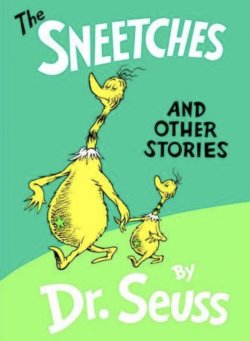Gareth B. Matthews

Review of The Sneetches and Other Stories by Dr. Seuss (New York: Random House, 1989). Originally published in Thinking: The Journal of Philosophy for Children 10(1): 1.
The recent death of Theodor Geisel, the “real-life” stand-in for the beloved Dr. Seuss, got me thinking about the amazing contribution this remarkable man had made to literature I almost said, “to children’s literature.;” which would have been right, though needlessly restrictive I agree with WH Auden, who wrote: “There are good books which are only for adults, because their comprehension presupposes adult experiences, but there are no good books which are only for children:” (Forwards and Afterwards) and certainly Dr. Seuss wrote some good books.
Dr. Seuss is famous for replacing “Dick and Jane” readers with books of zany rhymes that take the boredom out of phonics. But many of his stories are also philosophical. They are philosophical by presenting us readers with a thought experiment that provokes reflection.
Consider the story, “Too Many Daves;” which is included in this reprinting of four Seuss stories. The whole story consists of only twelve outrageously rhymed couplets, plus the familiar Seuss-type drawings. The story invites us to imagine a certain Mrs. McCave who “had twenty three sons and she named them all Dave.” The picture of 23 little Seuss creatures all responding at once to the call, “Come into the house, Dave.;’ makes the simple point that nothing can succeed in functioning as a proper name unless, in suitable contexts, it singles out one person from among others.
Though Dr. Seuss did show himself interested in philosophical questions like, “What constraints limit whether something can function as a proper name?” he was first, and most of all, a moralist. He clearly wanted to have a significant influence on the moral life of children, as well as, one suspects, the moral life of their elders. That motivation places him squarely in a venerable tradition that runs back through Hans Christian Andersen and Heinrich Hoffmann (inventor of Struwwelpeter) to Aesop and his ancient fables. What makes Dr. Seuss stand out from the tradition of moralism in children’s literature is the way he avoided being moralistic.
How can a moralist avoid being moralistic? Humorous verse certainly helps. So do zany drawings and ridiculous plots. But the plots need to be wisely ridiculous. And Dr. Seuss was a genius at thinking up wisely ridiculous plots.
The title story in this collection, “The Sneetches;” is a good example of Dr. Seuss’s special brand of moralism. The story begins with the odd fact that some of the weird creatures called “Sneetches” have stars on their bellies whereas others have “none upon thars:” Though the stars seem intrinsically insignificant, the star bellied Sneetches soon make this odd feature they happen to have into an important mark of distinction. For them their stars are a matter of great pride and a basis for discriminating against all the merely “plain-bellied” Sneetches.
Enter the entrepreneur, Sylvester McMonkey McBean. He has a machine for putting stars on erstwhile plain bellied Sneetches. With now no obvious mark of their own superiority, the originally star-bellied Sneetches let McBean use another machine he has available to take off the stars they were formerly so proud of. Now being a plain bellied Sneetch is “in” and having a star is not.
What McBean has put on he can, of course also take off. So, next, the freshly starred Sneetches now want their bellies unstarred. And so it goes-stars off, stars on, with McBean cashing in on the seemingly inexhaustible need of the original group to be obvious in their difference. Finally, however, all the Sneetches wise up. There comes a day when they realize that Sneetches are Sneetches and no kind of Sneetch is the best on the beeches. That day, all the Sneetches forgot about the stars and whether they had one, or not, upon thars.
Shrewdly, Dr. Seuss leaves the applications of his fable up to his readers. That is another way in which he avoids being, moralistic We have to think about the ways that we make invidious distinctions based on wearing the “right” kind of sneakers, getting the “in” haircut, having the preferred color of skin (even if you have to risk cancer to give it a tan), or boasting a “real” American name.
“The Sneetches;” like other stories by Dr. Seuss, can help us to examine the way we lead our lives by getting us to reflect on how “in group” behavior can lead to a ridiculous situation. That reflection can encourage us to ask whether some of our most basic attitudes toward others, toward ourselves, and toward life, are really, in John Wisdom’s useful phrase, “well-placed attitudes” after all.
